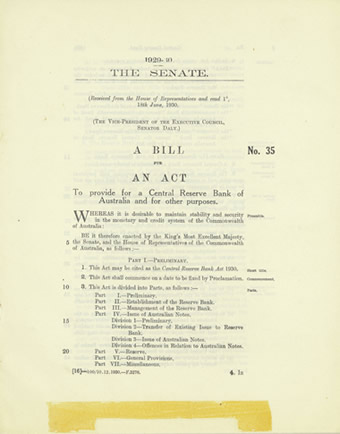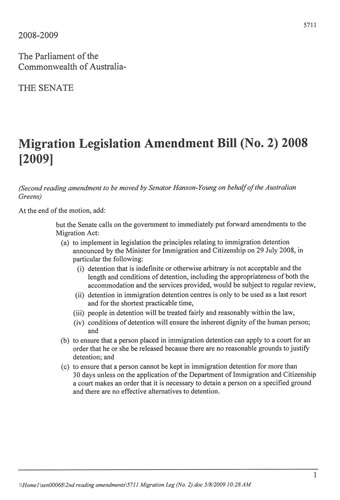114 Second reading
-
On the order of the day being read for the second reading of a bill, the question shall be proposed – That this bill be now read a second time.
-
An amendment may be moved to that question by leaving out “now” and inserting “this day 6 months”, which, if carried, shall finally dispose of the bill.
-
Other amendments may be moved to the question for the second reading provided that they are relevant to the bill.
Amendment history
Adopted: 19 August 1903 as SOs 186, 187 and 188 (corresponding to paragraphs (1) to (3)), but renumbered as SOs 185, 186 and 187 for the first printed edition
Amended:
- 9 September 1909, J.121 (to take effect 1 October 1909) (providing for referral of bills to select committees by way of second reading amendment)
- 11 March 1932, J. 46 (and see J.29 of 4 March 1932) (reversing the 1909 amendment)
1989 revision: Old SOs 193 to 195 combined into one, structured as three paragraphs and renumbered as SO 114; a reference to the previous question removed from paragraph (2) (covered elsewhere); paragraph (3) reframed as permissive rather than prohibitive
Commentary
These provisions reflect standard practices in the colonial legislatures and were agreed to after minimal debate.[1] Before the 1989 revision, paragraph (2) ended with the qualification, “or the Previous Question may be moved”.
In 1909, the Senate amended that provision to enable a bill to be referred to a select committee by means of a second reading amendment. Standing orders already contained provision for a bill to be referred to a select committee by motion after the second reading. By providing specifically for an amendment to the second reading motion, it was thought that the Senate would now gain the option of referring a bill before its second reading. As a consequence of this, the existing provision to refer a bill to a select committee by motion after the second reading (in what was then SO 188) was deleted.[2]
It needs to be appreciated that, at the time, these procedures were entirely theoretical. No government bill had been referred by the Senate to a select committee but the mechanism for doing so now appeared in bad company alongside the mechanism for finally defeating a bill at the second reading.[3]
The select committee appointed in 1929 to examine the advisability of standing committees in various areas also looked at the contribution that standing committees could make to the legislative process. Although it suggested that standing committees should wait until the Senate had had experience of select committee examination of bills, the committee did recommend that the Standing Orders Committee examine how the standing orders could be amended to facilitate the reference of bills to committees of either type.[4]
The Senate was soon to have its first experience of a government bill being referred to a select committee. On 10 July 1930, when debate on the motion for the second reading of the Central Reserve Bank Bill 1930 resumed, Senator Glasgow (Nat, Qld) successfully moved that the bill be referred to a select committee comprising eight senators and given full inquiry powers for the purpose.[5] After an interim report in which the committee urged the government to seek the views of Sir Otto Niemeyer and Professor Gregory while they were in Australia, and the government declined to do so, the committee received extensions of time to report so that it could obtain the views of these experts directly.[6] A final report was presented on 3 December 1930 and a motion moved to set the day for resumption of debate on the second reading of the bill.[7] Not surprisingly, given that it was composed entirely of opposition senators, the committee’s report was unsupportive of the bill and when debate resumed the following year, the bill was defeated by an amendment to leave out the word “now” and substitute “this day 6 months”.[8] The views of ministers in regarding the referral of a bill as a hostile move were thus reinforced, albeit in the context of the unusual circumstances fostered by the global financial crisis of the 1930s – the Great Depression.[9]
In light of these events, the Standing Orders Committee in its First report of the Twenty–fifth Session, tabled on 24 July 1931 and adopted on 11 March 1932, recommended various amendments, including the relocation of procedures for the referral of bills to select committees into a separate standing order. This necessitated a reversal of the amendment agreed to in 1909. See Australian Senate Practice, 3rd edition (1967), pp.212–13, for a detailed analysis of the 1932 changes.
|

The Central Reserve Bank Bill 1930, the first government bill referred to a select committee with unhappy results for the government
|

An amendment to the motion 'That this bill be now read a second time', also sometimes referred to as a 'pious amendment'
|
An amendment to the motion for the second reading which leaves out the word “now” and substitutes “this day 6 months” is regarded as finally defeating the bill. It is also known as the “dilatory amendment”.[10] Edwards gives an explanation for this provision as follows:
… most sessions of Parliament when the Standing Order was first used terminated in less than six months, so that by postponing a Bill for six months it was carried beyond the end of the session and lapsed with the prorogation. During recent years short sessions have been the exception rather than the rule, but the provision in the Standing Order to the effect that the carrying of the amendment “shall finally dispose of the Bill” places the matter beyond doubt.
Amendments of this kind are now rare and sometimes misunderstood to have a literal meaning (see SO 122).